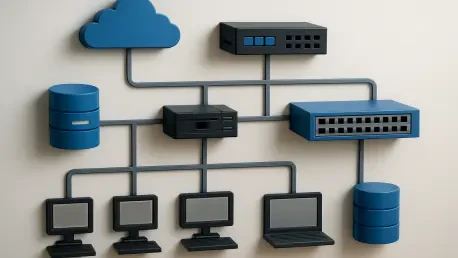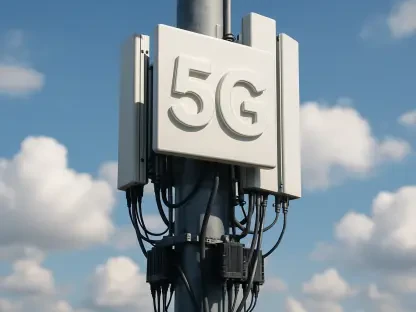In the evolving landscape of military defense, the rise of unmanned aircraft systems (UAS) presents an unprecedented challenge that demands innovative and adaptable strategies. The increasing prevalence and sophistication of drones have propelled the necessity for an agile and cohesive response mechanism within the military domain. Central to this response is the role of network architecture, a critical yet multifaceted component in transforming counter-UAS (C-UAS) strategies. Moving beyond the traditional reliance on isolated hardware solutions, modern approaches emphasize an integrated network that allows various sensors to work harmoniously within a single system. This enables military forces to consolidate multiple data streams into a coherent operational picture, enhancing situational awareness and decision-making capabilities.
A dynamic shift is underway, where successful counter-drone measures require robust network integration and sensor fusion to effectively detect and neutralize threats. The transition to network-centric strategies offers enhanced communication between command and control (C2) systems and the myriad sensors employed across different military branches. Such an approach underscores the need for seamless interoperability and the ability to swiftly process and disseminate information. As drone technology continues to advance rapidly, so too must the responses, demanding a strategic emphasis on integrating technologies that can maximize responsiveness and efficacy across all levels of military operations.
The Role of Network Architecture in C-UAS
Network architecture serves as the backbone for modern counter-UAS strategies, enabling military systems to transition from siloed operations to a synergized defense framework. This transformation relies on a common operational philosophy that unites diverse equipment and systems into a coherent mechanism for threat assessment and action. As technology continues to evolve, the value of an integrated network becomes increasingly apparent, allowing for enhanced collaboration and coordination across departments and branches. This integration lays the groundwork for a tactical advantage, facilitating real-time responses and ensuring an adaptive approach.
Sensor fusion plays a pivotal role in this interconnected environment. By merging data from a multitude of sources, sensor fusion creates a comprehensive and timely threat analysis, bridging the gap between detection and action. The goal is to eliminate unnecessary barriers between different data streams, thus fostering a more streamlined and accurate flow of information. Effective sensor fusion relies on meticulous alignment and timing to provide a single, continuous picture that aids commanders in making rapid yet informed decisions. The holistic approach to sensor data ensures clarity and accuracy, translating into actionable intelligence critical for addressing threats quickly and effectively.
Moreover, adopting an integrated network architecture diminishes the reliance on proprietary technology solutions that often hinder interoperability. By prioritizing open interfaces and government-led standards, military forces can reduce vendor lock-in and facilitate seamless integration of new technologies. This flexibility allows the military to remain adaptable, incorporating advancements that contribute to the overall strength and resilience of its C-UAS systems. In an era where threats are continuously evolving, maintaining a state of readiness and adaptability is crucial, demanding a mindset that favors network-oriented solutions over traditional, hardware-centric approaches.
Enhancing Communication and Data Flow
The successful transformation of C-UAS strategies hinges not only on integration but also on the quality and efficiency of communication and data flow within military networks. Real-time data transport is critical for transforming raw data from numerous sensors into actionable intelligence, necessitating an infrastructure that assures speed and reliability. By ensuring that information flows seamlessly across echelons, military operations can achieve heightened efficiency, improving response times and minimizing errors. This approach contrasts starkly with cumbersome, bespoke networks that often lead to inefficiencies and data silos.
Open-source application programming interfaces (APIs) offer a solution to these challenges by promoting interoperability and standardization. Implementing standardized APIs minimizes friction and ensures seamless compatibility among various sensor systems and effectors, thereby enhancing data exchange. This universality eliminates the bottlenecks associated with integrating disparate technologies, paving the way for quicker adaptation to new sensor technologies and analytical tools. Such an approach is critical for maintaining an agile defense posture in a domain where technological advancements are relentless and swift.
Furthermore, the management of track identities across different systems is vital to avoid confusion and ensure accurate threat assessments. Consistent track identity management eradicates duplication, confusion, and the potential for erroneous targeting, creating a streamlined picture that supports decisive action. The entirety of the network system must communicate efficiently to unify diverse sensor inputs into a singular operational view. Maintaining this coherence is essential for strategic superiority, allowing for precise identification and engagement of potential threats.
Strategies for a Future-Ready C-UAS System
As the defense landscape continues to evolve, the focus shifts to developing a future-ready C-UAS system that can seamlessly integrate emerging technologies and address sophisticated threats. The emphasis is on creating a common C2 system that spans all military branches within the Department of Defense, facilitating a universal communication architecture across varied platforms. This integrated approach seeks to bridge the gaps between individual service systems, enabling a standardized operational framework that supports interoperability and collaboration.
One crucial step toward achieving this goal involves developing a common C-UAS C2 framework that fosters joint capabilities among service branches. Selecting standardized APIs for integrating sensors and effectors ensures a unified and adaptable infrastructure. This approach not only supports cohesive communication but also accelerates the deployment of new sensor technologies, enhancing responsiveness and maintaining operational relevance. Moreover, prioritizing the development of a publish/subscribe engine at every echelon of command will streamline the exchange of intelligence, delivering crucial data to the right entities promptly.
Remote sensor tasking and fire control represent pivotal elements in a responsive C-UAS architecture, emphasizing the need for dynamic and precise engagements. These capabilities require a strong focus on network integration to ensure that all sensors and effectors operate collaboratively toward a common goal. Ensuring these components work together cohesively enhances the capability to detect, track, and engage hostile drones with precision and speed. By aligning sense, decision, and action—as essential elements of an interconnected system—defense forces can cultivate a robust, resilient posture capable of countering multiple contingencies effectively.
A Cultural and Operational Shift
In the ever-changing realm of military defense, the emergence of unmanned aircraft systems (UAS) poses a unique challenge, necessitating innovative and flexible strategies. The growing use and sophistication of drones make it essential for the military to establish an agile and coordinated response system. At the heart of this effort is network architecture, a complex but crucial element in reshaping counter-UAS (C-UAS) strategies. Rather than relying solely on isolated hardware solutions, modern military approaches now focus on an integrated network where diverse sensors function together within a unified system. This integration allows military forces to merge various data streams into a cohesive operational picture, improving situational awareness and decision-making abilities.
A significant transformation is underway in which effective counter-drone strategies depend on strong network integration and sensor fusion to successfully detect and counteract threats. Shifting to network-centric methods enhances communication between command and control systems and the wide array of sensors used across different military branches. This approach highlights the importance of seamless interoperability and efficient processing and distribution of information. As drone technology continues to evolve rapidly, so must the military’s responses, emphasizing the strategic integration of technologies that enhance responsiveness and effectiveness at all levels of operations.









